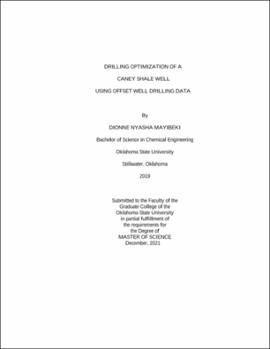| dc.contributor.advisor | Hareland, Geir | |
| dc.contributor.author | Mayibeki, Dionne Nyasha | |
| dc.date.accessioned | 2022-05-13T19:05:16Z | |
| dc.date.available | 2022-05-13T19:05:16Z | |
| dc.date.issued | 2021-12 | |
| dc.identifier.uri | https://hdl.handle.net/11244/335775 | |
| dc.description.abstract | Cost reduction can be achieved by utilizing drilling simulators to efficiently optimize new wells to be drilled using available adjacent or offset well drilling data. Different approaches involving simulators that use inverted rate of penetration (ROP) models have been implemented to help improve the drilling performance of wells primarily within the Caney shale. A complete simulation and optimization technique is presented herein which utilizes drilling data from a nearby or offset well (Garrett well) to create an optimized drilling program for a new well to be drilled (Gallaway well). The Pason Drilling Simulator (PDS), previously known as DROPS was used in this research to obtain an optimized drilling program for the Gallaway well. The PDS software uses inverted ROP models for different bit types, reported bit wear, lithological information, and pore pressure in addition to the drilling parameters. Raw drilling data from the offset well consisted of ROP, revolutions per minute (RPM) and mud weight among other drilling variables. Along with the PDS, the D-WOB software was run on the Garrett well drilling data to obtain the depth-based drill string friction coefficient and downhole weight on bit (DWOB) for every foot of the drilled well which is needed as an input into the PDS. The DWOB was analyzed, and results were compared to the SWOB to show the effect of wellbore friction on the weight-on-bit under downhole conditions. The results proved that the DWOB is significantly less than SWOB in the directional section of the well due to frictional losses along the wellbore. Several PDS simulations using the apparent rock strength logs (ARSL) and the concept of the learning curve were applied to define the optimum drilling parameters for the Gallaway well. To verify the accuracy of the PDS software, the simulation results will later be compared to results from actual field data from the Gallaway well by overlaying the ARSLs, the simulated ROP against the actual, and by analysis and observation of the trend displayed by plotting depth versus the unconfined rock strengths (UCS) of both wells in the different formations. The D-Series software will be used to obtain the ARSL for the drilled Gallaway well. | |
| dc.format | application/pdf | |
| dc.language | en_US | |
| dc.rights | Copyright is held by the author who has granted the Oklahoma State University Library the non-exclusive right to share this material in its institutional repository. Contact Digital Library Services at lib-dls@okstate.edu or 405-744-9161 for the permission policy on the use, reproduction or distribution of this material. | |
| dc.title | Drilling optimization of a Caney shale well using offset well drilling data | |
| dc.contributor.committeeMember | Al Dushaishi, Mohammed | |
| dc.contributor.committeeMember | Bikkina, Prem | |
| osu.filename | Mayibeki_okstate_0664M_17445.pdf | |
| osu.accesstype | Open Access | |
| dc.type.genre | Thesis | |
| dc.type.material | Text | |
| dc.subject.keywords | artificial intelligence | |
| dc.subject.keywords | drilling | |
| dc.subject.keywords | drilling simulator | |
| dc.subject.keywords | oil and gas | |
| dc.subject.keywords | optimization | |
| thesis.degree.discipline | Petroleum Engineering | |
| thesis.degree.grantor | Oklahoma State University | |
